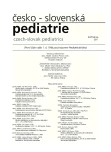Reactive hyperemic index and endothelial dysfunction in children – pilot study
Authors:
P. Jehlička; M. Huml; T. Votava; R. Pomahačová; J. Kobr
Authors‘ workplace:
Dětská klinika FN, Univerzita Karlova v Praze, Lékařská fakulta v Plzni
přednosta doc. MUDr. J. Kobr, PhD.
Published in:
Čes-slov Pediat 2011; 66 (2): 75-78.
Category:
Original Papers
Overview
The objective of this pilot study was to evaluate endothelial dysfunction (ED) in children with type 1 diabetes mellitus (T1DM) and in children following treatment for acute lymphoblastic leukemia (ALL). This data was then compared with healthy controls (HC). An EndoPAT 2000® recorder was used for the determination of the Reactive Hyperemia Index (RHI) by measuring postocclusive endothelium-dependent changes in vascular tone (PAT) in subjects’ fingertips.
A cohort of 35 eligible study participants comprising of 14 T1DM and 11 ALL patients were matched with a control group of 10 healthy children. Significantly lower RHI were revealed in T1DM patients in comparison with HC (1.50±0.56 vs. 1.99±0.68, p≤0.05), implying impaired endothelial-dependent dilation. ALL subjects tended to have lower RHI compared with HC (1.58±0.48 vs. 1.99±0.68, p>0.05). RHI brings an advantage compared to the other non-invasive methods.
Our pilot study showed that RHI might be a promising method in assessing ED in children with a high risk of premature atherosclerosis.
Key words:
endothelial dysfunction, children, RHI, T1DM, ALL
Sources
1. Berenson GS, Wattigney WA, Tracy RE, Newman WP 3rd, et al. Atherosclerosis of the aorta and coronary arteries and cardiovascular risk factors in persons aged 6 to 30 years and studied at necropsy (The Bogalusa Heart Study). Am J Cardiol 1992; 70(9): 851–858.
2. Corretti MC, Anderson TJ, Benjamin EJ, et al. International Brachial Artery Reactivity Task Force. Guidelines for the ultrasound assessment of endothelial-dependent flow-mediated vasodilation of the brachial artery: a report of the International Brachial Artery Reactivity Task Force. J Am Coll Cardiol 2002; 39 : 257–265.
3. De Roos NM, Bots ML, Schouten EG, et al. Within-subject variability of flow-mediated vasodilation of the brachial artery in healthy men and women: implications for experimental studies. Ultrasound Med Biol 2003; 29 : 401–406.
4. Hijmering ML, Stroes ES, Pasterkamp G, et al. Variability of flow mediated dilation: consequences for clinical application. Atherosclerosis 2001; 157 : 369–373.
5. Rubinshtein R, Kuvin JT, Soffler M, et al. Assessment of endothelial function by noninvasive peripheral arterial tonometry predicts late cardiovascular adverse events. Eur Heart J 2010 Feb 24 [E-pub ahead of print].
6. Jehlička P, Mayer O Jr. Pilot study of the noninvasive assessment of endothelial dysfunction by postocclusion dopplerometry velocity curves analysis in arteria brachialis. Čas Lek čes 2005; 144 : 43–46.
7. Haller MJ, Stein J, Shuster J, Theriaque D, et al. Peripheral artery tonometry demonstrates altered endothelial function in children with type 1 diabetes. Pediatr Diabetes 2007; 8(4): 193–198.
8. Hamburg NM, Keyes MJ, Larson MG, et al. Cross-sectional relations of digital vascular function to cardiovascular risk factors in the Framingham Heart Study. Circulation 2008; 117(19): 2467–2474.
9. Higashi Y, Sasaki S, Nakagawa K, et al. A noninvasive measurement of reactive hyperemia that can be used to assess resistance artery endothelial function in humans. Am J Cardiol 2001; 87 : 121–125.
10. Mahmud FH, Van Uum S, Kanji N, et al. Impaired endothelial function in adolescents with type 1 diabetes mellitus. J Pediatr 2008; 152(4): 557–562.
11. Bonetti PO, Pumper GM, Higano ST, et al. Noninvasive identification of patients with early coronary atherosclerosis by assessment of digital reactive hyperemia. J Am Coll Cardiol 2004; 44(11): 2137–2141.
12. Urbina EM, Williams RV, Alpert BS, et al. American Heart Association Atherosclerosis, Hypertension, and Obesity in Youth Committee of the Council on Cardiovascular Disease in the Young. Noninvasive assessment of subclinical atherosclerosis in children and adolescents. Recommendations for standard assessment for clinical research. A scientific statement from the American Heart Association. Hypertension 2009; 54(5): 919–950.
13. Jehlička P, Stožický F, Mayer O Jr, et al. Asymmetric dimethylarginine and the effect of folate substitution in children with familial hypercholesterolemia and diabetes mellitus type 1. Physiol Res 2009; 58(2): 179–184.
Labels
Neonatology Paediatrics General practitioner for children and adolescentsArticle was published in
Czech-Slovak Pediatrics

2011 Issue 2
Most read in this issue
- Extraesophageal reflux – otorhinolaryngological complication of gastroesophageal reflux
- Do we treate patients with cryptorchism at the recommended age?
- Cricopharyngeal achalasia, a rare cause of chronic irritable cough in infant
- Reactive hyperemic index and endothelial dysfunction in children – pilot study
